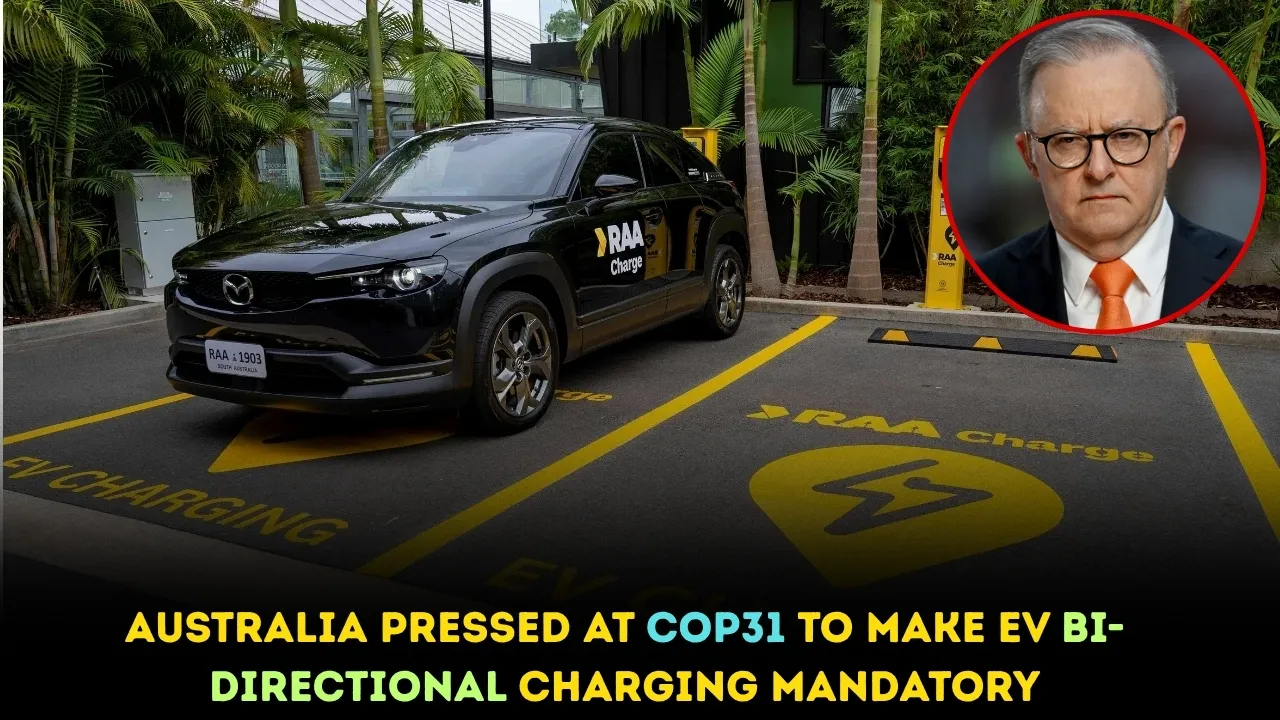Australia’s role at the COP31 climate summit created heated discussion, not just around coal exports or emissions cuts, but over a new frontier in clean energy tech: bi-directional charging for electric vehicles. The proposal, pushed by climate advocates and several international voices, called for Australia to make bi-directional charging mandatory in all new EVs sold from the coming years. While many see it as a breakthrough for the energy grid and households, others argue it could place costs and burdens on both carmakers and consumers.
What is bi-directional charging?
In simple terms, bi-directional charging allows an electric vehicle not just to pull energy from the grid but also to send it back. Instead of being only a mode of transport, your car could double as a mobile power bank, holding electricity for use during peak times or emergencies. Known as Vehicle-to-Grid (V2G) or Vehicle-to-Home (V2H), the technology has already seen uptake in Japan, South Korea, and parts of Europe.
Imagine plugging in your car after a day of charging from rooftop solar, then running your fridge, lights, and even air conditioning from that same car battery overnight. That’s more than futuristic convenience—it is energy resilience.
Why COP31 pushed Australia
Australia has one of the most ambitious solar uptake rates in the world. Rooftop solar is widespread, and renewable projects are rising sharply, yet a major challenge is energy storage. Battery farms exist, but they are costly and limited. Advocates at COP31 argued that millions of EV batteries sitting idle in driveways could be a decentralised solution.
Three key reasons were repeated during the summit:
- Grid stability: On hot summer evenings when air conditioners spike power use, EVs could release small amounts back to the grid, reducing reliance on coal and gas peaker plants.
- Cost savings: Households could recharge cars with cheap solar in the day and then feed that electricity into their home at night, saving hundreds of dollars on bills.
- Disaster backup: For communities facing bushfires, floods, or regional blackouts, an EV could keep essentials like lights, internet routers, or medical fridges running.
The case against immediate mandatory rules
Not every voice at COP31 was on board. Automakers raised concerns over costs of integrating bi-directional capability into all models. The upfront price of EVs could increase, potentially slowing adoption in a market already struggling with affordability.
Others highlighted a lack of standardisation across charging protocols, meaning not all EVs and chargers would work seamlessly together yet. There are also worries about how frequent charging and discharging might affect battery lifespan. Though research suggests the impact may be small, skepticism remains.
From a policy angle, the argument came down to whether governments should regulate and mandate this technology, or allow the market to drive its slower, natural adoption.
Australia’s official stance at COP31
The Australian delegation did not commit to mandatory rules, but left the door open. Officials spoke about ongoing EV incentives, growing charging infrastructure, and renewable energy rollout. They said further consultation with automakers and energy groups is needed before considering bi-directional charging mandates.
Essentially, the government leaned toward a cautious position, recognising the value of the tech but stopping short of introducing immediate regulation.
Reactions from climate advocates
For climate groups, the cautious stance failed to match the urgency of the crisis. Greenpeace and several energy think tanks demanded clear timelines for adopting V2G tech. One spokesperson bluntly stated: “Bi-directional charging is not a luxury—it’s a necessity for Australia’s clean future.”
They argue that waiting risks leaving Australia behind global leaders. With the International Energy Agency calling V2G a key part of decarbonisation strategies, activists believe Australia needs to act decisively or risk missing renewable targets.
What it means for everyday Australians
For now, the debate feels more policy-driven than practical for most drivers. But within five to ten years, the outcome could shape household budgets and energy reliability. A world where EVs replace gas plants during peak loads or power homes during grid outages is within reach.
For the average Australian family, that might mean:
- Lower energy bills by cycling between solar charging and night-time home use.
- Reliable back-up power during bushfires, floods, or heatwave-driven blackouts.
- A chance to contribute to national energy stability just by owning a car.
Of course, the appeal depends on costs. If automakers manage to integrate bi-directional systems without significantly raising prices, it could become a core part of EV adoption rather than a luxury feature.
Where things go from here
Australia’s hesitation at COP31 suggests bi-directional mandates might not come this year. But momentum is building, both globally and locally, for V2G to be part of the renewable transition. With Europe, Japan, and South Korea already moving in that direction, pressure from trade partners and international agencies is only likely to increase.
Domestically, the rise in rooftop solar installations and growing demand for energy storage could push policymakers to reconsider. If EV adoption surges as predicted, the argument for tapping hundreds of thousands of car batteries as a grid-balancing tool may become impossible to ignore.
Final thoughts
COP31 reminded the world that clean energy is not just about building wind farms and shutting down coal—it’s also about innovative, everyday solutions. Bi-directional charging could turn every EV into a small piece of a giant virtual power station. For Australia, with its unique mix of solar potential and energy challenges, the opportunity is huge.
The question now is whether policymakers are willing to make it mandatory and push automakers to deliver, or whether they risk stalling behind while other countries lead. For Australians facing high bills and unstable grids, this debate might soon move from global conferences into their very own garages.
